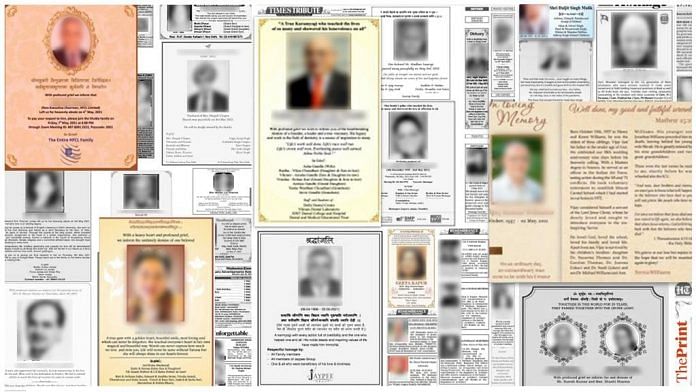New Delhi: “No farewell words were spoken, no time to say goodbye, you were gone before we knew it, and only God knows why,” read the lines of an obituary published in Hindustan Times on 16 May, dedicated to a man and his mother who died within 9 days of each other.
The newspaper published 10 obituaries that day. Last year, on the same day, it published one. An analysis of obituaries — usually a preserve of the relatively affluent given their steep costs — published in two of the leading English newspapers in the national capital suggests the second wave of Covid took a grave toll on the well-off as well.
The early weeks of May saw a deluge of obituaries in The Times of India and Hindustan Times.
A total of 870 obituaries were published in the two newspapers in May 2021, up from 204 in May last year.
Newspaper obituaries, which are not just tributes to the departed but serve to announce someone’s passing away as well, don’t come cheap. Obituaries in HT are priced at Rs 900 per square centimetre — a square with each side a cm long — and in TOI at Rs 970. Going by that rate, the smallest sized obit of about 24 sq cm would cost more than Rs 20,000.
Also Read: How diet, lifestyle & attitude have led Punjab to record India’s highest Covid death rate
What the obits tell us
In May 2021, The Times of India published an average of 17 obituaries a day, up from two last year. Hindustan Times, meanwhile, published 7 to 8 obituaries a day last month, compared to none or just one in the same time period last year.
“It’s mostly people with business backgrounds who opt for obituaries, and a bulk of announcements come from corporate businesses for their noted employees,” said an obituary coordinator with TOI who spoke on the condition of anonymity.
“The rest come from people who wish to announce the deaths of their parents or partners,” the coordinator added. “Because people with business backgrounds dominate the obituary space, most are dedicated to men. Obituaries are also expensive, and we have observed that people would rather spend for men.”
An analysis of the May 2021 obituaries that listed age and gender — 714 of the 870 — revealed that only 25 per cent were for women.
Referring to these trends, Dr Jugal Kishore, a public health expert and head of community health at Safdarjung Hospital, Delhi, said that in his experience, more men tend to die of Covid compared to women.
“There could be a number of reasons for this — one could be that women are mostly confined to home. Men have more exposure to the outdoors, thus, leading to more cases,” he added.
“Secondly, even if a man and woman are infected by the virus at the same time, the woman recovers much faster as compared to the man. We can say the female gender is the stronger one as compared to the males as far as immunity and antibodies production is concerned. It could also be because of smoking and drinking habits being more prevalent in men, leading to more comorbidities,” he told ThePrint.
An unbearable loss
Sanjeev Jain’s photograph was among 32 others in The Times of India’s two-page spread of obituaries on 7 May. He had passed away due to Covid-19 on 26 April, but his family of nine struggled to put out an obituary on time. All of them had been infected with the virus, and some of them were fighting to survive at the time.
“I lost my mother-in-law too, just a few days after my husband. It’s been a devastating loss,” said Ruchi Jain, Sanjeev’s wife. When he began showing symptoms around 10 April, as cases were steadily rising in the city, the first hurdle was getting a test. The second was getting a bed after his condition deteriorated. The third was watching, helplessly, as his symptoms got worse.
Sanjeev was 58, had no comorbidities, and had taken one dose of the vaccine when he died.
“My son had to carry out two cremations at a young age while he himself had Covid. Half of us couldn’t be there. What do you tell yourself?” said Ruchi. “All the stats go out of the window. We’re traumatised by the news, and by this experience.”
Naresh Sharma, another Delhi resident, said his brother and sister-in-law both died on consecutive days due to Covid, on 30 April and 1 May. They were admitted to hospital but succumbed to Covid after their oxygen level dropped.
Suresh Kumar (69) and his wife Shashi Sharma (64), he added, had taken both doses of the vaccine and developed symptoms a month after getting the second shot. “They were both admitted in different hospitals where there was no shortage of oxygen at the time. Once they went to the ICU, they never came back,” Sharma said.
A man who lost 12 of his relatives to Covid in Delhi, and issued an obituary for two of them, said, “We did not face any shortage (of hospital beds, oxygen) as such, but we think they died due to the negligence of the doctor. Both my wife’s parents also lost their lives a day after my mother died, and my aunt also succumbed to the disease within a week. It has been a terrible loss.”
(Edited by Sunanda Ranjan)
Also Read: Death and journalism: India’s Covid deaths are undercounted, but twice the Partition toll?



